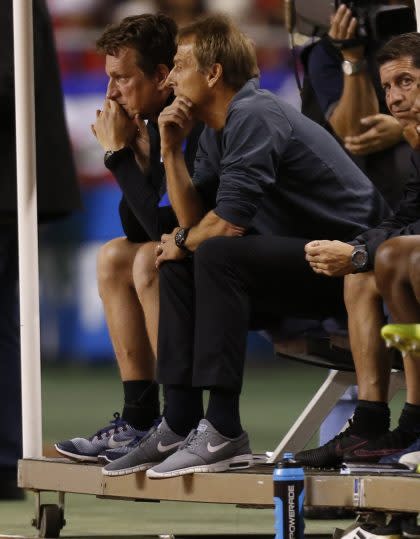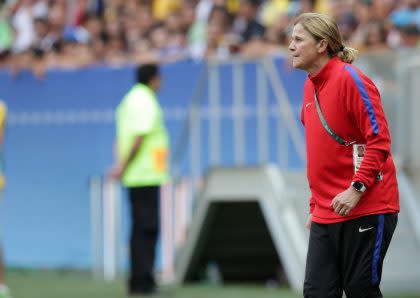Why U.S. Soccer needed a year of adversity and failure like 2016

This was not a banner year for the United States Soccer Federation.
[ FC Yahoo’s 2016 review: Story of the Year | Person of the Year ]
It fired its men’s national team coach after a half decade of treading water. The women’s national team, in the midst of an increasingly adversarial collective bargaining negotiation and federal equal pay discrimination grievance, had its worst performance at a major tournament ever, followed by yet more Hope Solo-related drama. The men’s under-23 team wasn’t at the Olympics for a third time in four cycles. The under-20 women had an underwhelming World Cup, scraping out a fourth-place finish.
Oh, and the second-tier North American Soccer League is on its deathbed.
Yet 2016, in a lot of ways, was the year U.S. Soccer needed to have.

It had been apparent for a while that on the senior men’s national team side, the Jurgen Klinsmann Era was quickly turning into the Klinsmann Debacle. There was hardly anything redeeming about the five years he’d been in charge – save for a solid World Cup performance – when almost no tangible progress of note was recorded. There was, and is, very little to show at the senior team level for the $15 million or so Klinsmann had earned as senior team head coach and technical director – a dual role that seemed to conflict with itself.
When the USA imploded completely in its final World Cup qualifier of the year in Costa Rica, a 4-0 drubbing in which the players looked, to put it charitably, disinterested, it was as apparent as ever that Klinsmann wasn’t going to make a success of the job. It was widely speculated that he might be allowed to hang on through the 2018 World Cup, but the Americans were clearly not going to get anywhere close to the semifinal place Klinsmann had set as their target. Reaching Russia at all was now in peril, after losses in the first two games of the final round of qualifiers – an unforgivable transgression in what is surely the most forgiving qualifying region in the world.
It was time to move on. Klinsmann’s replacement – and predecessor from 1998 through 2006 – Bruce Arena can’t be expected to reach that final four, but at the very least the program will be injected with some fresh energy. And gone is the pretense that the same players who once performed best as an athletic, counter-punching team can somehow be transformed into Spain or Germany overnight.
In the grand scheme of things, cutting this experiment short was a good thing, even though it meant conceding that half a decade was practically wasted. U.S. Soccer took a step back so that it might enable progress.
This was also true on the women’s side, to an extent.
It’s tricky and largely unfair to affix too much meaning to a tournament elimination on penalties in a knockout game, but the facts are that the USA hadn’t exactly set the Rio Olympics alight before Sweden knocked the Americans out in a quarterfinal shootout. They had made a slow start at the 2015 Women’s World Cup as well, before roaring to the title. But this time around, the U.S. couldn’t shake off its slow start.

It was the first time in 13 Women’s World Cups and Olympic tournaments – which is to say, all of them ever played – that the Americans weren’t in the semifinals. Indeed, it was the first time that they didn’t place third or better. But this historic failure has also been oddly productive.
Head coach Jill Ellis was in no danger of losing her job, on account of her long contract extension and a first world title in 16 years. And in more than two years since succeeding Tom Sermanni, she clearly hadn’t been able to remake the team as she had wished. Like every other U.S. women’s coach, she ran into the traditional hierarchy and the considerable power it wields over the team’s own fate with the federation. As a rule, the senior players don’t allow for a lot of changes, because those almost always come at the expense of, well, the senior players. A failure to recognize this had gotten Sermanni fired.
But now that the string of 12 consecutive medals was broken, Ellis had an unprecedented mandate to shake the cobwebs out of her team. In 2016, she accelerated the process of rebuilding and modernizing a side that could sometimes feel stale in a women’s game that’s undergoing a rapid technical evolution. This year, she brought in no fewer than 19 new players and called up a total of 21 players who were 24 years old or younger.
Ellis punched through the stasis in a way that was long overdue but not previously possible. And she was able to do it because of a single loss on penalties.
None of this undoes the woes at the youth national team levels, which continue to baffle considering there is doubtless more talent in the pools of either gender than ever before. (For the record, the men’s Olympic team’s failure to qualify occurred in late 2015, not in 2016.)
And it’s hugely unsettling that the NASL is facing long odds of even playing in 2017. That upstart circuit may have made its mistakes and could look silly in its grandstanding pronouncements of competing with top-tier Major League Soccer, but the American game is inarguably better for having more professional leagues and clubs. That one league might be wiped out next year, even if that means the extinction of fewer than 10 clubs, is bad news for all.
Serious questions should probably be asked about whether U.S. Soccer could have done more to prevent this. After it all, it bankrolls the National Women’s Soccer League simply because it benefits the national soccer scene for it to exist. That would have been drastic and maybe counterproductive in the NASL’s case, but the federation is so deeply embedded with MLS that its lack of support for a league that on occasion made noises about competing is troubling.
Yet good things happened in 2016 that didn’t merely exist as silver linings to bad things.
Even if the U.S. men’s national team turned in an up-and-down performance – or, to be exact, a down-and-up-and-down performance – at the Copa America Centenario, that tournament, held stateside, was a sporting and commercial success. And it reinforces once again that America should be considered very seriously to host the 2026 World Cup – a privilege that is overdue.
To that end, U.S. Soccer helped itself by apparently brokering Gianni Infantino’s election as the new FIFA president in February by swinging the decisive block of votes into his column. There’s no telling yet if FIFA will really be better off under Infantino than fellow Swiss Sepp Blatter. But at the very least, the man at the top will likely be friendlier to American interests than his predecessor, who felt threatened by U.S. law enforcement.
If Infantino isn’t good for the game, he could still be good for the U.S. That’s perhaps a cynical view, but just as plenty of other things in 2016 were bad for American soccer on the surface, they could potentially prove beneficial in the long run. Because 2016 was a challenge on almost all fronts. But it was also a year that could foretell better ones to come.
Leander Schaerlaeckens is a soccer columnist for Yahoo Sports. Follow him on Twitter @LeanderAlphabet.

 Yahoo Sports
Yahoo Sports 

